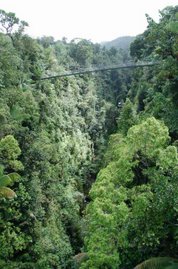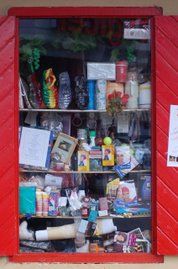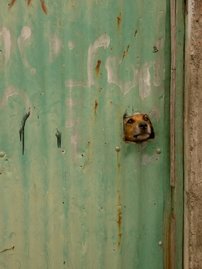Roseau is a town that still hasn’t suffered from hardcore, development aid funded, well paid restaurateurs who have transformed the buildings to dollhouses, the streets to artificial tourist shopping streets, the town to a museum, to a so called “export-ready” heritage site. Roseau is still alive, full or real people, running real errands, living in real houses. I really don’t know how the Caribbean used to be, but I get the feeling Roseau is quite a bit as it used to be. Maybe with more cars.

The other day we were having lunch at the Fort Young Hotel. Up on the second floor veranda we started talking to the people at the table next to ours. Visiting from St Martin for the weekend they wanted tips on where to go for a couple of day tours. We talk about Trafalgar Falls, Soufriere hot springs, going snorkeling at Champagne or Scots Head, and more. And then come to ask them how they like it so far. “Oh”, says the young woman, “its great, it remains me of Saint Martin twenty years ago. I really, really hope it can remain this way.” Dominica’s population is about 70.000, compared with same size Martinique’s 450.000 or St Marten with the same amount of inhabitants, on 15% the size of Dominica. As soon as you leave Roseau, there is a more or less total absence of large development projects, the little villages remains little villages where life remain rural and slow, just as it always have used to be. The absence of international hotel chains, charter tourists, golf courses and international airport helps, of course, to contribute to all this. And Dominica’s newly approved Tourism Policy states that “Dominicas extraordinary tourism resources cannot be experienced without exploring the country” and that all tourism should benefit the local communities. However, both the Prime Minister and the Minister of Tourism seem interested in playing golf, and change is, always, inevitable. And definitely not always bad.
The absence of international hotel chains, charter tourists, golf courses and international airport helps, of course, to contribute to all this. And Dominica’s newly approved Tourism Policy states that “Dominicas extraordinary tourism resources cannot be experienced without exploring the country” and that all tourism should benefit the local communities. However, both the Prime Minister and the Minister of Tourism seem interested in playing golf, and change is, always, inevitable. And definitely not always bad.
This month the EU-funded 6 million euro “Eco-Tourism Development Programme” just finished. The programme has enabled for the upgrade of more than 20 tourist sites, shape-ups of certain areas in Roseau, training and awareness building on the importance of tourism for local communities and a lot more. The work constantly carried out by S.H.A.P.E., the society for heritage architecture preservation and enhancement, have resulted in a greater awareness of the beauty of many of the historical buildings, and in the importance of preserving this heritage and its memories, to progress slowly and with care.
Dominica is an island with many nicknames. The most common must be “the Nature Island of the Caribbean”, or, as the official website now states, just “the Nature Island”. Dominica’s nature is incredible, and it is worth visiting just for experiencing all the different shades of green, I still cant believe there are so many, but Dominica has even more to offer than nature. The ride through narrow, winding roads, short breaks at small hilltop villages, a fruit juice or cup of bush tea, a kubuli and some fish and provision at the very local restaurant or little café, the warmth of the people. These are the real experiences. It is Caribbean as it used to be. Or maybe it is Dominica - Caribbean just the way it is.






1 comment:
Nice article, but the name is actually Waitukubuli. You switched a u with an a. Waiukubuli means how tall is a body in the Kalinago language
Post a Comment